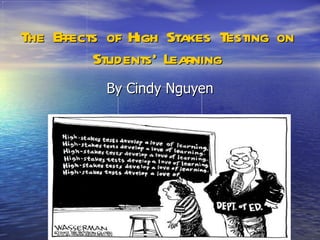
Nguyen c researchpowerpoint
- 1. The Effects of High Stakes Testing on Students’ Learning By Cindy Nguyen
- 2. Problem Statement High stakes testing does not increase students’ learning.
- 3. What? Purpose… The goal of this research is to understand the effects of high stakes testing on students’ learning.
- 4. . This research is important because it affects how school system operates. Why? Rationale…
- 5. Who? People involved… -Students -Teachers -Parents -Government Officials -School Officials -District Officials
- 6. Benefits of the research… -Changes in schools’ grading policy -Changes to teachers’ incentive system -Help create new policies regarding assessments
- 7. History of High Stakes Testing… -In the 1980s, the U.S. education system were deemed “ at risk ” of failure
- 8. -To counter this, lawmakers started transforming the schools’ system with high stakes testing playing a major role
- 9. Pros of High Stakes Testing 1. Quality of American education can be greatly improved by a system of rewards and sanctions that results from students’ test performance
- 11. 2. The effects of high stakes testing threaten the validity of test scores, but also lead to “perverse” and “corrupt” educational practice
- 12. What influence high stake testing? No Child Left Behind Law , passed in 2002
- 13. No Child Left Behind (NCLB) -States must have a set of academic standards -Assessments to monitor the progress of students to meet those set of standards
- 14. -Schools must report to the states these assessment’s scores divide into different categories and sub groups (ethnicity, economic background, etc.)
- 15. -States must create a rating system on the schools base on the data they sent about the students’ scores
- 16. - States must create a plan (Adequate Yearly Progress or AYP) that would ensure 100 percent of its students will reach academic proficiency by the year 2014–2015
- 17. - States must come up with a system of accountability that includes rewards and sanctions to schools, educators, and students that are tied to whether they meet state’s goals outlined in the AYP plan.
- 18. Research Report -I decided to do a little research about this topic. Since my school does a lot of mock TAKS testing days. I decided to examine students’ score over time.
- 19. Data – Class Averages
- 20. Findings -No significant changes in students’ progress -Scores were consistent
- 21. Conclusion High stakes testing does not improve or hinder students’ progress.
- 22. Bibliography Braun, H. (2004, January 5). Reconsidering the impact of high-stakes testing, Education Policy Analysis Archives, 12 (1). Retrieved [Date] from http://epaa.asu.edu/epaa/v12n1/. Nichols, S. L., Glass, G. V, & Berliner, D. C. (2006). High-stakes testing and student achievement: Does accountability pressure increase student learning? Education Policy Analysis Archives, 14 (1). Retrieved [date] from http://epaa.asu.edu/epaa/v14n1/. Supovitz, Jonathan. 2010. Is High-Stakes Testing Working? Penn GSE . Retrieved from http://www.gse.upenn.edu/review/feature/supovitz.